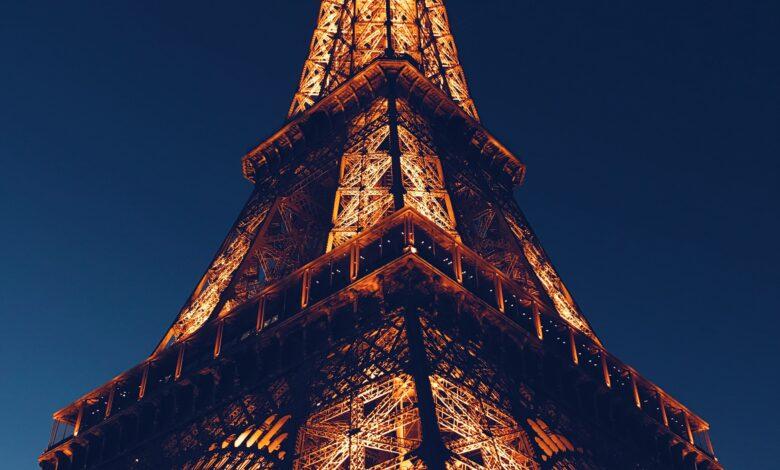Paris Beyond the Eiffel Tower: Hidden Gems in the City of Light ✨
Unveiling Secret Treasures and Local Delights

Introduction
Paris, often described as the City of Light, is renowned for its iconic landmarks—the Eiffel Tower, the Louvre, and Notre-Dame Cathedral. While these famous sites are undeniably captivating, there’s a whole other side to the French capital waiting to be explored. Paris hides a treasure trove of lesser-known gems, where history, art, and culture come to life away from the tourist throngs. In this blog post, we invite you to venture beyond the Eiffel Tower and delve into the hidden treasures of the city. From the bohemian charm of Montmartre to the serene Père Lachaise Cemetery, the picturesque Canal Saint-Martin, and more, you’ll discover the Paris that locals cherish and travelers dream of. So, lace up your walking shoes, and let’s embark on a journey to uncover the hidden gems of the enchanting City of Light.
Montmartre: The Bohemian Heart of Paris
Explore the Charming Streets of Montmartre
Nestled on a hill in the 18th arrondissement of Paris, Montmartre exudes an irresistible charm that has captivated artists, dreamers, and wanderers for generations. Its winding, cobbled streets and quaint alleys are a true testament to the village-like allure that characterizes this bohemian enclave.
As you stroll through Montmartre, you’ll find yourself transported to a bygone era. The streets are lined with historic buildings adorned with vibrant ivy, making it a photographer’s paradise. One of the most iconic thoroughfares is Rue Lepic, where you can enjoy the sights and sounds of local life, and perhaps, if you’re lucky, spot a vintage Citroën 2CV ambling along the charming roads.
Café des 2 Moulins is a must-visit. Immortalized in the movie “Amélie,” this café encapsulates the quirky and artistic spirit of Montmartre. Don’t forget to sample some delicious French pastries with your coffee.
From the Place du Tertre, you can observe artists at work, offering an authentic glimpse into Montmartre’s long-standing artistic heritage. Their easels dot the square as they capture the neighborhood’s essence on canvas.
Visit the Lesser-Known Art Studios and Cafés
While Montmartre is celebrated for its artistic legacy, there are hidden gems beyond the bustling tourist spots. Venture off the beaten path to discover the lesser-known art studios and cafés that add a layer of authenticity to your experience.
Atelier de la Lumière is one such hidden treasure. This artists’ workshop provides a serene refuge for painters, sculptors, and photographers to create their masterpieces. You can even catch a glimpse of their works in progress or engage in conversations with the artists themselves.
Café Le Consulat, tucked away on a quiet corner, is another delightful find. Its rustic charm and unpretentious ambiance make it the ideal place to unwind and savor a café crème or a glass of wine. Enjoy the vintage décor and feel like you’ve stepped back in time.
Sacré-Cœur Basilica and Its Panoramic Views
Perched atop the highest point in Montmartre, the Sacré-Cœur Basilica is a masterpiece of architectural grandeur and a symbol of spiritual importance. The gleaming white domes of this Roman Catholic basilica can be seen from various vantage points in the city, drawing visitors to its stunning location.
Inside, the basilica’s beauty is equally awe-inspiring, with its intricate mosaics and breathtaking stained glass windows. A sense of tranquility permeates the interior, providing a welcome respite from the bustle of city life.
However, it’s the panoramic views from the basilica’s terrace that truly steal the show. As you climb the steps, you’ll be rewarded with a sweeping vista of Paris that stretches as far as the eye can see. The Eiffel Tower, the Seine River, and iconic landmarks dot the skyline, creating a mesmerizing tableau that’s especially enchanting at sunset.

The Enigmatic Père Lachaise Cemetery
Famous Graves and Tales of the Departed
Père Lachaise Cemetery in Paris is a place where history, art, and the ethereal come together. It’s renowned for its famous residents, and their stories are woven into the very fabric of this enigmatic necropolis.
The grave of Jim Morrison, the iconic frontman of The Doors, is a pilgrimage site for music lovers. With graffiti-adorned tombs and tributes, it’s an ever-evolving memorial. Oscar Wilde’s tomb is equally fascinating, covered in lipstick kisses from admirers. You can’t help but be intrigued by the mystery surrounding Père Lachaise.
But it’s not just the stars who rest here; the ordinary graves tell tales of love, loss, and lives lived. Each tombstone hides a story, and as you wander through the labyrinthine paths, you’ll discover the narratives of countless individuals, all interred in this hallowed ground.
A Quiet Escape from the City’s Hustle and Bustle
Amidst the urban bustle of Paris, Père Lachaise Cemetery offers a peaceful sanctuary. It’s a place of reflection, a tranquil escape from the city’s relentless energy. The moment you step through its ornate gates, you’re enveloped in an atmosphere of calm.
The meandering paths are shaded by ancient trees, making it an ideal spot for a leisurely stroll. You’ll often find visitors sitting on benches, reading a book, or simply enjoying the serenity. The chirping of birds and the rustling of leaves create a soothing symphony that’s worlds away from the urban cacophony.
Whether you’re seeking solitude, a break from sightseeing, or a place to contemplate life’s mysteries, Père Lachaise is a refuge where you can slow down, breathe, and find solace.
The Cemetery’s Historical Significance
Père Lachaise Cemetery has a rich history that extends beyond its famous occupants. Established in 1804, it was a bold departure from the conventional, crowded city graveyards of the time. Napoleon Bonaparte himself played a role in its creation, envisioning a place that would honor the deceased with dignity and grandeur.
The cemetery’s layout reflects the neoclassical architectural style of the 19th century. As you explore, you’ll encounter magnificent mausoleums, intricate sculptures, and grand tombs that are a testament to the era’s art and architecture.
Over the years, Père Lachaise has become a symbol of Paris itself, not just a resting place but a testament to the city’s enduring spirit. It’s a blend of art, history, and memory, where the departed live on in the hearts of those who visit.
The Canal Saint-Martin: A Local’s Paradise
A. Stroll Along the Scenic Canal Banks
The Canal Saint-Martin, a hidden gem in the heart of Paris, offers a serene escape from the city’s bustling streets. Strolling along the scenic canal banks is a delightful way to experience the authentic Parisian lifestyle. Lined with graceful trees and charming footbridges, the canal exudes a timeless, romantic ambiance.
As you meander alongside the water, you’ll encounter locals and tourists alike, all drawn to the canal’s tranquil allure. The canal banks are perfect for leisurely walks, picnics, or simply sitting by the water’s edge to soak in the peaceful atmosphere. The picturesque reflections in the canal create a postcard-worthy backdrop, making it a favorite spot for both photographers and painters.
B. Discover Hidden Boutiques and Cafes
One of the Canal Saint-Martin’s most enchanting aspects is its vibrant neighborhood brimming with hidden boutiques and quaint cafes. This is where the true spirit of the local Parisians shines through.
You’ll find a plethora of charming boutiques offering unique fashion, antiques, and handmade crafts. These are the kind of shops that locals frequent to find one-of-a-kind treasures, and you can join in on the adventure. Explore the cobbled streets that wind away from the canal, and you’ll stumble upon delightful surprises, from vintage clothing stores to artisanal bakeries.
When you need a break, there’s an array of cozy cafes and bistros. Sip on a café crème or savor a croissant in these local haunts. The outdoor seating provides the perfect vantage point for people-watching as you absorb the neighborhood’s lively yet relaxed vibe.
C. Witness the Mesmerizing Lock System in Action
The Canal Saint-Martin boasts a unique feature that captivates both locals and visitors – its functioning lock system. Watching the locks in action is like witnessing a piece of living history.
As you sit by the canal, you may witness boats and barges navigating the series of locks, rising and descending as they traverse the canal’s varying water levels. The process is a marvel of engineering, and the sight of the lock gates opening and closing is both mesmerizing and educational.
The lock system adds an extra layer of charm to the canal, reminding us of the vital role it has played in Paris’s history as a means of transportation and commerce. This living testament to the city’s past is something you won’t want to miss during your visit.
Parc des Buttes-Chaumont: A Natural Oasis
A Picturesque Park Designed by Napoleon III
Parc des Buttes-Chaumont, nestled in the heart of Paris’s 19th arrondissement, is a testament to the city’s ability to seamlessly blend urban sophistication with natural beauty. This picturesque park was designed by Napoleon III in the mid-19th century, and it’s a testament to his vision of creating green oases amidst the urban sprawl.
As you enter the park, you’ll be greeted by sweeping lawns, lush groves, and well-manicured gardens. The meandering pathways take you through a landscape that’s both meticulously planned and wonderfully wild. It’s a perfect spot for a leisurely stroll or a romantic picnic.
The park’s centerpiece, a stunning man-made lake, is surrounded by cliffs and dense foliage, giving it an almost otherworldly feel. At its highest point, a suspension bridge offers panoramic views that are simply breathtaking. It’s hard to believe that this idyllic escape is just a stone’s throw away from the bustling streets of Paris.
Bridges, Cliffs, and a Temple Atop a Man-Made Island
Parc des Buttes-Chaumont isn’t your typical city park. Its unique topography is a major draw, characterized by dramatic cliffs, picturesque bridges, and a temple perched atop a man-made island. The park’s most iconic bridge, known as the “Swing Bridge,” gently sways as you cross, adding a touch of adventure to your visit.
The pièce de résistance, however, is the Temple de la Sibylle, which appears as though it was plucked from ancient Rome and placed in the heart of Paris. This temple, inspired by the Roman Temple of Vesta, sits atop the island and is surrounded by a placid lake. It’s a popular spot for visitors to relax, take in the views, and appreciate the park’s architectural marvel.
For the more adventurous, the rugged paths and rocky cliffs provide an opportunity to explore hidden nooks and crannies, creating a sense of exploration rarely found in urban parks.
Tranquility Amid the Urban Sprawl
One of the most remarkable features of Parc des Buttes-Chaumont is its ability to provide tranquility amid the hustle and bustle of urban life. It’s a place where you can escape the city’s frenetic pace and immerse yourself in nature, without leaving the city limits.
The sound of cascading water from the park’s waterfall, the rustling leaves in the breeze, and the songs of birds all create a serene ambiance. Locals and visitors alike come here to find solace, practice yoga, or simply read a book beneath the shade of a tree.
Le Marais: A Historic and Trendy Neighborhood
Explore the Marais District’s Rich History
Le Marais, a historic and trendy neighborhood in the heart of Paris, is a treasure trove of the city’s rich history. Stepping into the Marais district feels like a journey back in time, as it boasts some of the best-preserved medieval architecture in Paris. This area has been witness to centuries of change and evolution.
Wandering through the narrow, winding streets, you’ll come across historic landmarks such as the Hôtel de Ville (City Hall) and the Place des Vosges, a stunning square dating back to the 17th century. The area was once home to the French nobility, and their exquisite mansions, now turned into museums and galleries, stand as testaments to the district’s opulent past.
Le Marais also played a significant role in LGBTQ+ history, with a thriving queer community that has left an indelible mark. The neighborhood’s history is a captivating blend of the old and the new, creating a unique tapestry of Paris’s past and present.
Boutique Shopping and Delectable Dining
Le Marais is celebrated for its vibrant shopping and dining scene. The streets are lined with trendy boutiques, making it a haven for fashion enthusiasts. From vintage shops offering one-of-a-kind finds to chic designer stores, there’s something for every style.
While exploring, don’t miss the mouthwatering culinary experiences the neighborhood offers. Le Marais is a food lover’s paradise, with an array of cafes, bakeries, and restaurants serving up delectable treats. Sample traditional French pastries, savor a croissant with your coffee, or indulge in a leisurely meal at a cozy bistro.
For those who appreciate international flavors, you’ll find a diverse array of eateries, from Middle Eastern falafel shops to kosher delicatessens. The culinary options in Le Marais are as diverse as its history.
Hidden Courtyards and Historic Mansions
Behind the elegant façades of Le Marais lie hidden courtyards and historic mansions waiting to be discovered. These secret oases offer respite from the bustling streets and a glimpse into the neighborhood’s aristocratic past.
Many of these courtyards are tucked away behind unassuming doors, but once you step inside, you’re transported to a world of tranquility and charm. You might find yourself in a quiet garden, surrounded by the timeless beauty of ivy-covered walls and weathered stone.
The historic mansions, known as “hôtels particuliers,” are equally captivating. Some have been converted into museums and galleries, like the Musée Picasso Paris, which is housed in the Hôtel Salé. Exploring these mansions allows you to touch the very soul of Paris, experiencing the opulence and artistry of bygone eras.
Offbeat Museums: A World of Curiosities
Musée de la Chasse et de la Nature
Nestled in the heart of Paris, the Musée de la Chasse et de la Nature (Museum of Hunting and Nature) is a captivating testament to the intriguing relationship between humans and the natural world. This offbeat museum is a treasure trove for those seeking a unique and thought-provoking experience.
The museum’s collection is a celebration of art, history, and science. It showcases a wide array of artifacts, from intricately designed hunting weaponry to taxidermy specimens that allow you to get up close and personal with some of the world’s most magnificent creatures. The exhibits delve into the evolution of hunting, both as a necessity for survival and a sport of kings.
What sets this museum apart is its fusion of contemporary art with its historical exhibits. You’ll find modern artworks seamlessly integrated with the traditional displays, offering fresh perspectives on the themes of nature, wildlife, and the human connection to the animal kingdom. It’s a truly immersive experience that’s bound to leave you pondering the intersection of culture and the environment.
The Museum of Romantic Life
Tucked away in the charming neighborhood of Pigalle in Paris, the Museum of Romantic Life is a hidden gem that allows you to step back in time to the romantic 19th century. This museum, dedicated to the Romantic era, is housed in the former residence of Dutch-born artist Ary Scheffer, and it exudes an air of elegance and nostalgia.
The museum’s collection includes art, literature, and personal items that offer a glimpse into the lives of prominent Romantic artists and writers. You’ll find letters, portraits, and memorabilia from the likes of George Sand, Frédéric Chopin, and Gustave Flaubert. The enchanting gardens surrounding the museum provide a serene escape from the city’s hustle and bustle.
But perhaps the highlight of this museum is the tearoom, a peaceful retreat where you can savor a cup of tea and pastries in a lush, green setting. It’s the ideal place to contemplate the art and literature of the Romantic period, surrounded by the ambiance that inspired some of the most enduring works of the era.
Explore Unique Collections Away from the Crowds
One of the most enticing aspects of offbeat museums is their ability to offer a respite from the crowds that often inundate more popular tourist attractions. These unique collections cater to the discerning traveler, providing an intimate and contemplative atmosphere.
Exploring these offbeat museums allows you to engage with history, culture, and art in a way that’s both immersive and personal. The smaller scale of these institutions often means you can take your time, ask questions, and truly absorb the knowledge they have to offer. It’s an opportunity to savor the details and discover hidden gems that might be easily overlooked in larger, more crowded venues.
FAQs
Q. When is the best time to visit Paris?
A. The best time to visit Paris is in the spring (April to June) and fall (September to November) when the weather is pleasant, and the city is less crowded.
Q. Are these hidden gems suitable for families with children?
A. Yes, many of these hidden gems are family-friendly and offer a unique experience for children as well.
Q. Can I visit these places with limited French language skills?
A. Absolutely! Many Parisians speak English, and these attractions are accustomed to welcoming international visitors.
Q. How do I navigate the Parisian metro system to reach these hidden gems?
A. The Paris metro is an efficient way to travel around the city. Simply purchase a ticket or a metro pass, and you’ll have easy access to all these destinations.
Q. Are these hidden gems free to visit?
A. While some attractions may have an entrance fee, many of the hidden gems mentioned in this guide are free to visit or offer affordable admission fees.
Q. Can I use public transportation to reach these destinations?
A. Paris has an excellent public transportation system, including buses and the metro, making it convenient to access all these hidden gems.
Conclusion
As we draw the curtain on our journey through hidden Paris, we hope you’ve caught a glimpse of the city’s lesser-known wonders—the secrets that only the curious and the adventurous uncover. Paris, with its rich history, artistic soul, and timeless charm, has so much more to offer beyond its famous attractions. We encourage you to continue exploring this vibrant city, seeking out its hidden gems, and making your own discoveries. Perhaps you’ll stumble upon a cozy café in Le Marais, feel the history come alive in the Père Lachaise Cemetery, or find inspiration in the streets of Montmartre, just as countless artists and writers have for centuries. Paris is a city that reveals its magic to those who dare to look beyond the obvious. So, as you bid adieu to the Eiffel Tower, remember that the City of Light has many more stories to tell and treasures to share. Bon voyage, and may your Parisian adventures be filled with wonder and delight.
NEXT ARTICLE





Facebook Comments